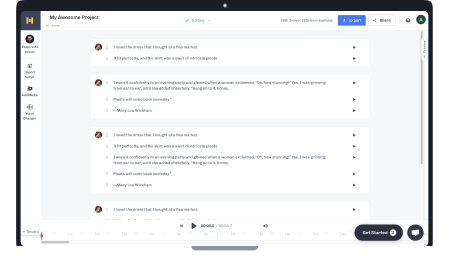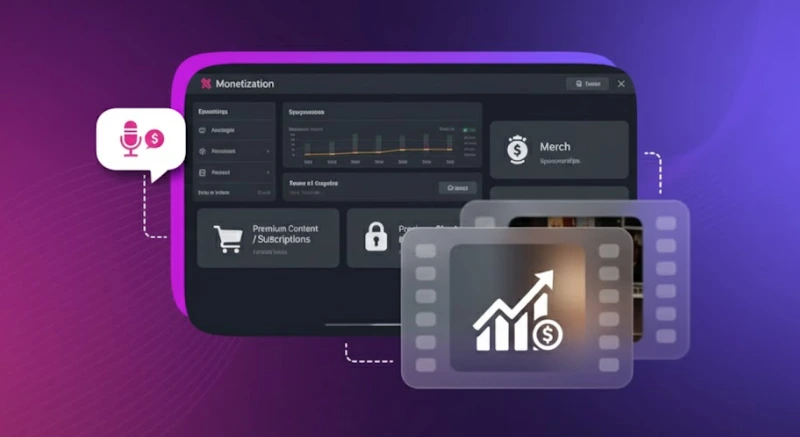How to Start a Podcast With Zero Audience? A Step-by-Step Beginner’s Guide
.webp)
Starting a podcast feels overwhelming when you have zero listeners. While millions listen to podcasts daily, few actually create them. This gap represents your opportunity to start a podcast from scratch and build something meaningful.
Every successful podcast began with zero podcast listeners. What separates successful podcasts from failed ones isn’t audience size but following a clear process from the start.
Let's begin with the most crucial step that determines whether your podcast thrives or fades off within three episodes.
Step 1: Plan Your Podcast Before Recording Anything
Planning prevents the most common podcasting mistake: quitting after three podcast episodes. Most new podcasters skip this step, record randomly, and burn out quickly. A solid plan keeps you consistent when motivation fades.
The foundation of any successful podcast is clarity on your concept and target audience. Without this clarity, you'll waste time creating podcast content that nobody searches for or cares about.
Define Your Specific Niche
Generic podcast topics disappear in the sea of 5 million existing podcasts. The more specific your podcast topic, the easier it becomes to attract a dedicated podcast audience who need exactly what you offer.
"Teaching productivity" is too broad. "Productivity tips for night shift nurses" attracts a specific target audience with real problems. Browse Apple Podcasts and Google Podcasts to find gaps where demand exists but quality content doesn’t.
Examples of focused niches that work:
- Personal finance for freelance designers
- Cooking for college students with one hot plate
- Running tips for people over 50
Create Your Ideal Listener Profile
Successful podcasts speak to one listener persona, not everyone. Creating a detailed listener persona transforms your podcast content from generic advice to specific solutions.
Give your target audience a name and routine. Sarah, 34, emergency room nurse, works three 12-hour night shifts weekly. She uses podcast apps during her 45-minute commute and needs productivity tips that work with irregular sleep schedules. When recording your first podcast episode, speak directly to Sarah.
Choose Your Format and Plan Episodes
Your podcast format determines workload and content style. Solo shows provide complete control but require strong monologue skills. Co-hosted shows with a podcast host partner create dynamic conversation. Interview formats bring fresh perspectives to your podcast theme.
Plan your first five podcast episodes before recording anything. This proves you have enough podcast content and gives new listeners multiple episodes to binge. For a productivity podcast with no audience, you might cover: morning routines, meal prep strategies, exercise with rotating shifts, and building social connections.
With your podcast concept clear, you need the right tools to bring it to life. Professional-sounding podcasts no longer require thousands in podcast equipment investment.
Step 2: Set Up Your Recording Space for Under $100
Professional equipment is optional when starting out. Your content quality matters far more than having broadcast-standard gear. Many successful podcasts still use basic setups because valuable high quality content keeps potential listeners coming back.
A $50 microphone upgrade improves audio far more than a $500 mixing board for beginners. Focus your investment on recording software and sound quality improvements.
Essential Equipment by Budget
Transform Any Room Into a Studio
Your recording space impacts sound quality more than an expensive microphone. Pick the quietest room to minimize background noise. Closets work perfectly because clothes naturally prevent audio feedback.
Follow these hacks for quick soundproofing:
- Hang blankets on walls to reduce background noise
- Use a podcast stand to position equipment properly
- Turn off all fans to improve audio recording
- Put towels under equipment to reduce vibration
Download Audacity or other free recording software for audio recording and editing.
.jpg)
For professional podcast intros without hiring voice talent, Murf AI's voice generator creates broadcast-quality audio files instantly.
Now that your recording space is ready, it's time to record audio for your first episode and overcome the mental hurdle.
Step 3: Record and Edit Your First Episodes
Recording your first episode often feels awkward since few people like hearing their own voice. This universal discomfort stops many from starting a podcast anonymously or publicly. Push through knowing it fades with practice.
Before you record audio: close unnecessary programs, silence phones, have water nearby, and write bullet points for your podcast content. Start each audio recording session with 10 seconds of silence for noise reduction during editing.
Recording Best Practices
Speak naturally into the mic as if talking to a friend. If you mess up, pause for two seconds, then repeat the sentence. This makes editing with recording software easier. Avoid speaking too fast or apologizing for mistakes while recording.
Murf AI's transcription feature converts your audio files into searchable text, helping search engines find your podcast. The platform also helps with audio dubbing in podcast production for reaching new listeners globally.
Essential Editing Steps
Basic editing with editing software elevates your new podcast to professional quality. Focus on four priorities that improve sound quality:
- Remove silences longer than 3 seconds from audio files
- Reduce excessive "ums" (keep some for authenticity)
- Normalize volume levels across the episode
- Add podcast intro/outro using Murf AI
Create eye-catching podcast cover art readable at thumbnail size. Design podcast artwork using bold colors and minimal text. Your podcast description should include your podcast name and explain value: "[Podcast Name] helps [target audience] achieve [specific goal]. Each episode delivers [what] in [episode length] or less."
Everything is prepared for launch. Now comes distributing your podcast across all podcast platforms where potential listeners discover new shows.
Step 4: Upload to All Major Platforms
Distribution through podcast directories determines your reach. Publishing across all major podcast directories and podcast platforms maximizes discovery since most podcast listening happens on preferred apps. Meet your podcast audience where they already listen.
Platform Distribution Guide
When you start a podcast on Spotify, you reach 35.8 million monthly users. The process takes 2-4 hours: create an account, enter your podcast title and details, upload your RSS feed from your podcast hosting service, and submit for review.
Apple Podcasts reaches 28.5 million users but takes longer for approval. Use a free podcast host like Anchor to automatically distribute your RSS feed everywhere:
Your new podcast now lives on all major podcast apps. The real work begins: transforming curious browsers into loyal listeners who help you start a podcast with no audience and grow it.
Step 5: Grow From Zero to Your First 1,000 Listeners
Growing a podcast requires patience and consistent daily actions. Most successful podcasts see meaningful growth between months 6-12. Understanding this timeline prevents discouragement when starting a podcast with no audience.
Week 1-4: Foundation Building
Your first month sets habits for podcast successful growth. Share with your existing audience (even if just friends), post in relevant social media platforms, and gather listener feedback from three honest people.
Establish a daily growth routine: respond to comments, share podcast content clips, engage with other podcasts in your niche, and monitor podcast analytics for patterns.
Month 2-6: Momentum Building
This phase separates growing podcasts from stagnant ones. Reach out to other podcasts with similar audience sizes about guest swaps. Even with 50 downloads per episode, other new podcasters need quality podcast content too.
Use this template: "Hi [Name], I love your podcast about [topic]. I host [your podcast] for [target audience]. Would you be interested in swapping appearances? I could share insights on [your expertise] with your new listeners. Happy to go first."
Long-Term Growth Strategies
Consistency beats everything for a podcast successful trajectory. Publish on schedule even when downloads disappoint. Use analytics to learn what resonates and create more of that content.
.webp)
Apply these growth accelerators:
- Create audiograms for social media presence
- Write a blog post from each episode for search engines
- Build email lists beyond social media platforms
- Use voice cloning to repurpose content
.webp)
Success leaves clues, and failures follow patterns. Learning these patterns prevents common mistakes that kill new podcasts.
Step 6: Avoid These Beginner Mistakes
Learning from others’ mistakes saves time and frustration. These mistakes appear small but compound into problems that prevent building more listeners.
Technical Mistakes: Poor audio quality from bad podcast microphones drives away potential listeners faster than boring content. Missing scheduled podcast episodes breaks trust. Build buffer episodes for emergencies. Ignoring SEO means search engines can't find your podcast website.
Content Mistakes: Broad podcast topics attract nobody. Narrow focus builds loyal listeners faster. Structure your podcast format to prevent rambling. Use outlines for each episode title. Implement listener feedback from early supporters.
Growth Mistakes: The podcasting industry rewards patience. Most take 6-12 months gaining traction. Other podcasts aren’t competition. Build relationships and share audiences. Email lists outlast social media presence changes.
Remember, every successful podcast host made these mistakes before finding their rhythm. The difference is they kept recording through the learning curve instead of letting perfectionism stop them from publishing.
Start Recording Today
You now have everything needed to start a podcast with no audience successfully. The tools are affordable, podcast platforms welcome beginners, and your unique perspective matters to someone searching for your exact podcast theme.
Stop waiting for perfect conditions. Open recording software right now and record audio for a two-minute introduction. This single action puts you ahead of everyone planning to start a podcast "someday."
Future listeners are searching for answers only you can provide. Every delay means they miss your insights. The gap between dreamers and creators is a single recorded episode. Which side will you choose today?

Frequently Asked Questions
How to start a podcast as a nobody?
.svg)
Being a "nobody" helps you start a podcast anonymously or experiment freely. Focus on solving specific problems for a small podcast audience rather than appealing to everyone. Use Murf AI for professional sound quality immediately. Engage genuinely with every early listener. Remember that successful podcast hosts like Joe Rogan started with zero audience.
Can I start a podcast anonymously?
.svg)
Yes, you can publish a podcast anonymously using a pseudonym on all major podcast directories. Create separate accounts for your anonymous podcast. However, remaining anonymous limits networking in the podcasting industry and building an existing audience. Consider using just your first name if complete anonymity isn't essential.
How many people do you need to start a podcast?
.svg)
Just you! Solo podcasts work perfectly as your own podcast for teaching or storytelling. Many podcast successful shows feature one podcast host. Starting alone maintains creative control of your podcast format. Add co-hosts to your podcast theme as you gain more listeners.
What is the minimum equipment to start a podcast?
.svg)
Your smartphone works, but investing $50-100 in podcast microphones dramatically improves audio recording quality. Get a USB mic and use free tools like Audacity as recording software. Add a pop filter to prevent audio feedback. Upgrade podcast equipment as your podcast audience grows.
How often should I post new episodes to see consistent growth?
.svg)
Weekly podcast episodes generate fastest growth keeping you visible on podcast apps. However, biweekly works if sustainable long-term. Consistency matters more than frequency for podcast listening habits. Missing episodes damages trust. Build 3-4 episode buffer before launching your first podcast episode.




.webp)
.webp)








